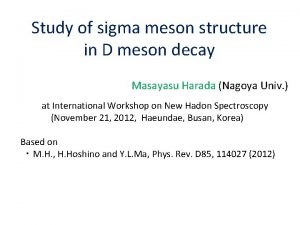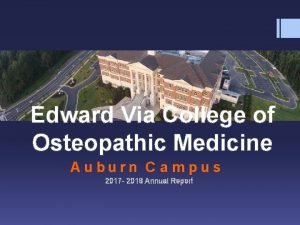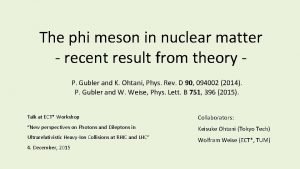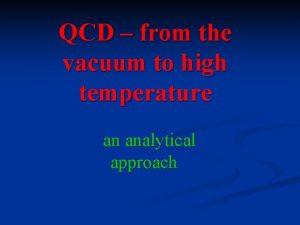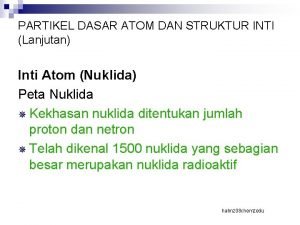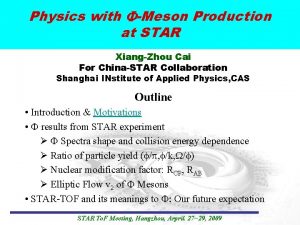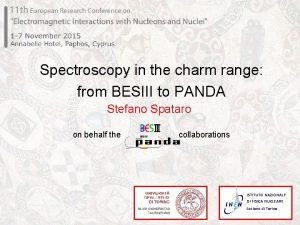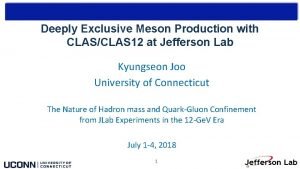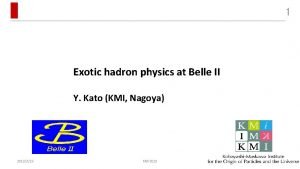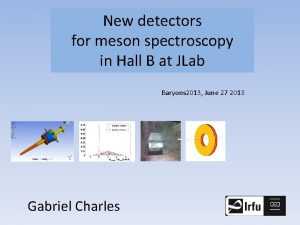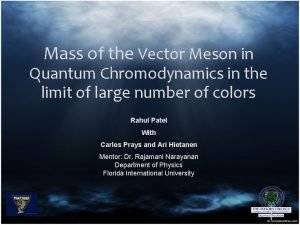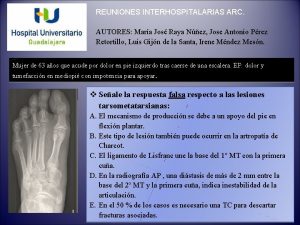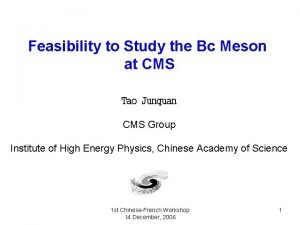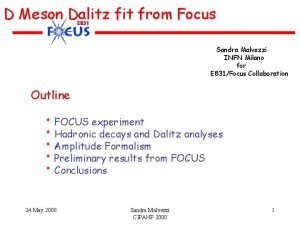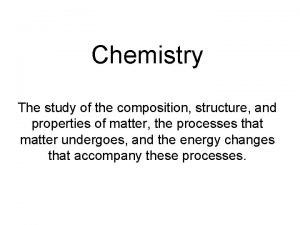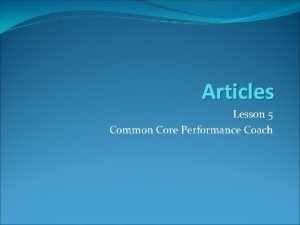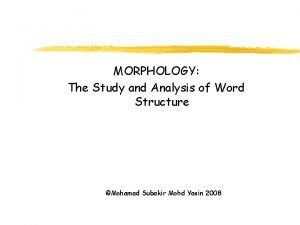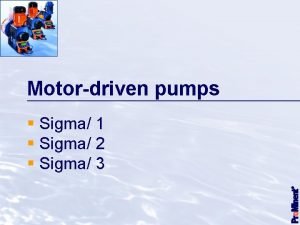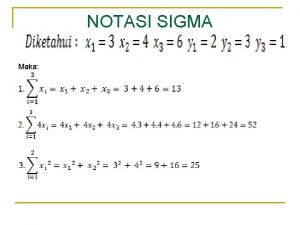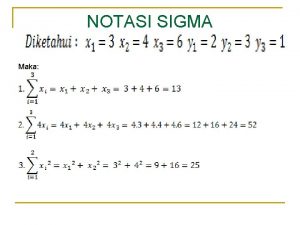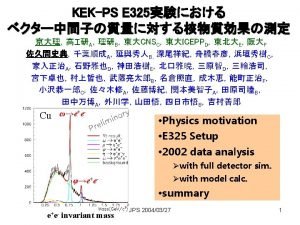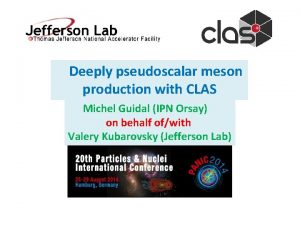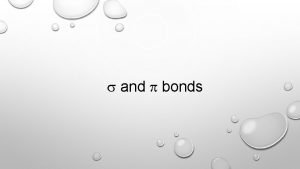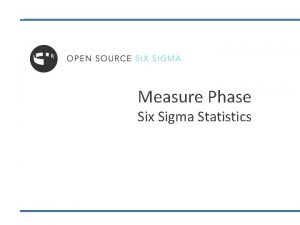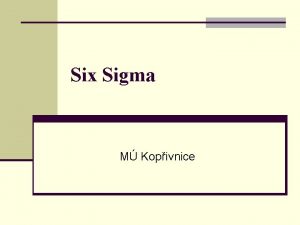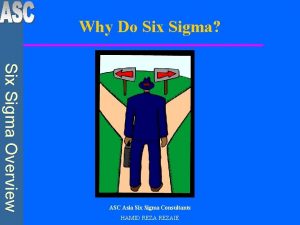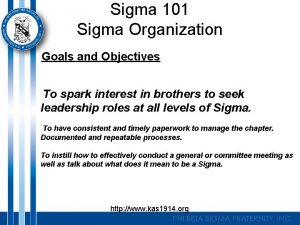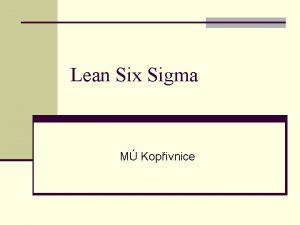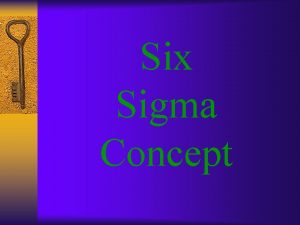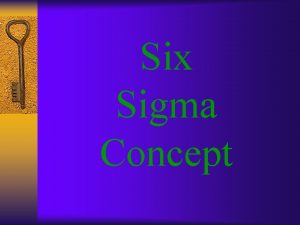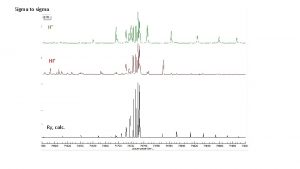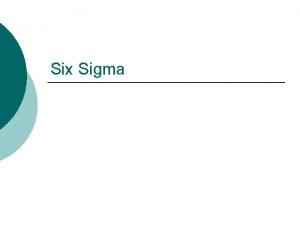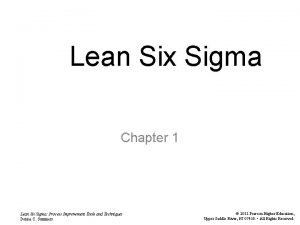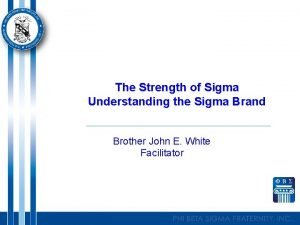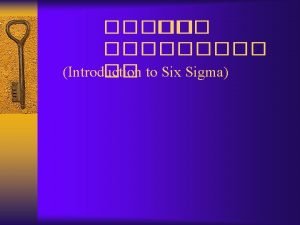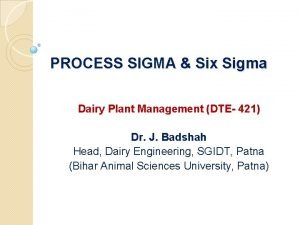Study of sigma meson structure in D meson


























- Slides: 26

Study of sigma meson structure in D meson decay Masayasu Harada (Nagoya Univ. ) at International Workshop on New Hadon Spectroscopy (November 21, 2012, Haeundae, Busan, Korea) Based on ・ M. H. , H. Hoshino and Y. L. Ma, Phys. Rev. D 85, 114027 (2012)

1. Introduction

☆ “σ” particle (“QCD Higgs” particle) ・・・ Quantum fluctuation of the quark condensate → Clue to understand the chiral symmetry breaking A candidate ・・・ f 0(500) : lightest I=0 scalar meson In this talk, I cal f 0(500) the s meson. However, f 0(500) may not be a qqbar meson ! PDG 2012

◎ Standard qqbar quark model assignment What is f 0(500) ? 2 quark ( qqbar ) state “σ” particle 4 quark ( qqqbar ) state Exotic hadron

Outline 1. Introduction 2. Quark Structure of Scalar Mesons 3. Linear sigma model for light quark sector including s meson 4. s meson in pp scattering 5. s meson in D 1 → Dpp decay 6. Summary

2. Quark Structure of Scalar Mesons

2 -quark picture of scalar mesons mass (Me. V) f 0(500) Contradiction ?

Scalar meson puzzle mass (Me. V) f 0(500) Consistent ?

3. Linear sigma model for light quark sector including s meson

2 and 4 quark states in linear sigma model Amir H. Fariborz, Renata Jora, and Joseph Schechter, PRD 72, 034001 (2005) 3× 3 matrix fields & (Linear Sigma Model): 4 quark field ~ 2 quark field ~ Scalar Pseudo scalar These transform in the same way under SU(3)L×SU(3)R : SU(3)R× SU(3)L: Different transformations under U(1)A : U(1)A:

U(1)A Symmetry ? ◎ Anomaly is suppressed in the large Nc QCD Current is conserved. U(1)A is spontaneously broken by the quark condensate. ◎ Definition of the spontaneously broken charge Light-front axial charge is well-defined. see, e. g. , S. Weinberg, Phys. Rev. 177 (1969) 2604.

mixing When the U(1)A symmetry exists, 2 -quark state and 4 -quark state do not mix with each other. But, the U(1)A symmetry is broken by anomaly explicitly by spontaneous chiral symmetry breaking ⇒ mixing between 2 -quark state and 4 -quark state Lightest 2 nd 3 rd Heaviest

An effective Lagrangian Linear sigma model including 2 -nonet fields : SU(3)L×SU(3)R invariant, U(1)A invariant. : SU(3)L×SU(3)R invariant, U(1)A breaking (anomaly). constrained by anomaly matching with QCD : Explicit SU(3)L×SU(3)R×U(1)A breaking terms. (effects of current quark masses)

Phenomenological Analysis using a special form of the potential A. H. Fariborz, R. Jora, and J. Schechter, PRD 79, 074014 (2009) Note : A 2/A 1 = md/mu ; A 3/A 1 = ms/mu generate mixing between 2 -quark and 4 -quark states

Phenomenological Study of f 0(500) Inputs : fixed values mp = 137 Me. V ; Fp = 92. 6 Me. V m[ a 0(980) ] = 987. 4 Me. V, m[ a 0(1450) ] = 1474 Me. V; A 2/A 1 = md/mu = 1 variable values 1200 Me. V < m[ p(1300) ] < 1400 Me. V (exp: 1300 ± 100 Me. V) 20 < A 3/A 1 = ms/mu < 30 • masses of I=0 scalar mesons • Mass hierarchy is reasonably reproduced. • Note that the light sigma meson appears automatically in the present model.

Quark Contents of f 0(500) percentage of components fa fc fd fb fa = (uubar + ddbar)/√ 2 ; fb = ssbar ; fc = (usubarsbar + dsdbarsbar)/√ 2 ; fd = udubardbar • ex: for m[ p(1300) ] = 1215 Me. V, fa : fb : fc : fd = 0. 36 : 0. 04 : 0. 36 : 0. 24 → The f 0(500) includes about 40% 2 -quark and 60% 4 quark. • The lightest scalar is roughly about half 2 -quark and half 4 -quark state.

4. s meson in pp scattering

pp scattering in the linear s model Relations among coupling constants due to the chiral symmetry π π π pp scattering amplitude includes spp couping and sigma mass in the low energy region σ

Fit to pp scattering data

5. s meson in D 1 → Dpp decay

“chiral doubling” M. A. Nowak, M. Rho and I. Zahed, PRD 48, 4370 (1993) excited states heavy quark symmetry (heavy quark partner ) ground states chiral symmetry (chiral partner) MD(0+, 1+) – MD(0 -, 1 -) ~ 0. 43 Ge. V Chiral doubling seems to work.

U(1)A of D mesons ◎ Assume D(0 -, 1 -) and D(0+, 1+) ~ c qbar ⇒ U(1)A eigenstates : DL ~ D(0 -, 1 -) – D(0+, 1+) → DL e-in DR ~ D(0 -, 1 -) + D(0+, 1+) → DR e+in ⇒ Only 2 -quark light-mesons can couple to D mesons. This scalar meson is made of 2 -quarks. (Not a mass eigenstate) note : M(2 -quark) → M e+2 in ; M’(4 -quark) → M’ e-4 in

D 1 → Dpp decay We determine gspp and ms by fitting to pp scattering.

D 1 → Dpp decay width gspp > 0 gp. DD > 0 gspp < 0 gp. DD > 0 gspp > 0 gp. DD < 0 gspp < 0 gp. DD < 0 Constituent of sigma meson may be determined by future experiment

6. Summary ◎ We construct an effective model including the light scalar masons and the D mesons. • U(1)A symmetry plays an important role: • Heavy meson can couple only to 2 quark mesons. ◎ We study an effect of the sigma meson to D 1 → Dpp decay • Our result indicates that we can get some clues to understand the composition of the sigma meson from future experiments.

 Sigma meson
Sigma meson Vcom white coat ceremony
Vcom white coat ceremony Edward via college of osteopathic medicine - auburn campus
Edward via college of osteopathic medicine - auburn campus Phi meson
Phi meson Meson valves
Meson valves Partikel meson
Partikel meson Lucas 10 30-37 enseñanza
Lucas 10 30-37 enseñanza K star meson
K star meson B meson decay
B meson decay Clasclas
Clasclas B meson decay
B meson decay Meson
Meson Meson
Meson Irene mendez meson
Irene mendez meson Bc meson
Bc meson Sandra malvezzi
Sandra malvezzi Case series
Case series Retrospective cohort study vs prospective cohort study
Retrospective cohort study vs prospective cohort study Work study definition
Work study definition Marty lobdell study less study smart
Marty lobdell study less study smart Phytogeographical regions of world
Phytogeographical regions of world Work study objectives
Work study objectives Distinguish between time study and motion study
Distinguish between time study and motion study The study of composition structure and properties of matter
The study of composition structure and properties of matter Lesson 5 articles answer key
Lesson 5 articles answer key Morphology the study of word structure
Morphology the study of word structure Syllable structure
Syllable structure
